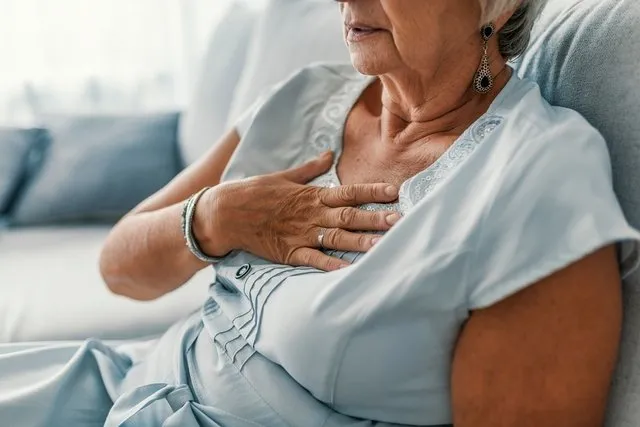First aid for a heart attack not only helps save the person’s life but also prevents the appearance of sequelae, such as heart failure or arrhythmias. Ideally, first aid should involve recognizing the symptoms, calming and making the victim comfortable, and calling an ambulance, calling SAMU 192 as quickly as possible.
A heart attack can affect any apparently healthy person, but it is more common in the elderly or people who have untreated chronic illnesses, such as high cholesterol, diabetes or high blood pressure, for example. See more about the main causes of heart attack.

When a heart attack is suspected, the following steps must be taken:
1. Recognize the symptoms
A person who suffers an acute myocardial infarction typically experiences the following symptoms:
- Intense pain in the chest, like burning or tightness;
- Pain that can radiate to the arms or jaw;
- Pain that lasts for more than 15 minutes without improving;
- Feeling of shortness of breath;
- Palpitations;
- Cold sweats;
- Nausea and vomiting.
In addition, the person may also experience intense dizziness and fainting. Learn how to recognize the symptoms of a heart attack.
2. Call for medical help
After identifying the symptoms of a heart attack, it is recommended to immediately call for medical help by calling SAMU 192, or a private mobile care service.
3. Calm the victim
In the presence of symptoms, the person may become very anxious or agitated, which can worsen the symptoms and the severity of the condition. Therefore, it is important to try to remain calm and help the person to relax until the medical team arrives. To do this, you can do the exercise of breathing deeply and calmly, counting to 5 when inhaling or exhaling.
Furthermore, it is also important to avoid the accumulation of people around the victim, as this not only reduces the amount of oxygen available, but also causes increased stress.
4. Loosen tight clothes
While the person is trying to relax, it is recommended to loosen tighter clothes and accessories, such as belts or shirts, as this makes breathing easier and also helps to keep the person more comfortable.
5. Offer 300 mg of aspirin
Giving 300 mg of aspirin helps thin the blood and may help reduce symptoms until medical help arrives. Aspirin is recommended in cases where the person has never had a heart attack before and does not have allergies. Therefore, they should only be offered to people whose health history is known.
In cases where the person has a history of another previous heart attack, the cardiologist may have prescribed a nitrate tablet, such as Monocordil or Isordil, to be used in emergencies. Therefore, aspirin should be replaced with this tablet.
6. Monitor your breathing and heartbeat
Until the medical team arrives, it is very important to maintain a regular assessment of vital signs such as breathing and heartbeat to ensure that the person is still conscious.
Read too: Vital signs: what they are, table (and how to measure)
What to do if a person faints or stops breathing?
If the victim faints, they should be left lying in a comfortable position, with their stomach up or on their side, always checking their heartbeat and breathing.
If the person stops breathing, cardiac massage maneuvers should be started immediately until the ambulance arrives or until the heart starts beating again. See how to do cardiac massage correctly.
Bibliography
- AMERICAN HEART ASSOCIATION. Understand Your Risks to Prevent a Heart Attack. Disponível em: <https://www.heart.org/en/health-topics/heart-attack/understand-your-risks-to-prevent-a-heart-attack>. Acesso em 28 abr 2020
- VIRTUAL HEALTH LIBRARY. Heart attack (infarction). Available at: <https://bvsms.saude.gov.br/dicas-em-saude/2779-ataque-cardiaco-infarto>. Accessed on April 28, 2020
- ST JOHN QLD. First aid for heart attack. Disponível em: <https://www.stjohnqld.com.au/getmedia/d8e07dc3-4278-43d3-ae62-4e8656dd394c/heartattack2012.pdf.aspx?ext=.pdf>. Acesso em 28 abr 2020
- AMERICAN RED CROSS. Responding to Emergencies Comprehensive First Aid/CPR/AED. Available at: <https://www.redcross.org/content/dam/redcross/atg/PDFs/Take_a_Class/RTE-IM-lesson9-10.pdf>. Accessed on April 28, 2020

Sign up for our newsletter and stay up to date with exclusive news
that can transform your routine!
Warning: Undefined array key "title" in /home/storelat/public_html/wp-content/plugins/link-whisper-premium/templates/frontend/related-posts.php on line 12
Warning: Undefined array key "title_tag" in /home/storelat/public_html/wp-content/plugins/link-whisper-premium/templates/frontend/related-posts.php on line 13



